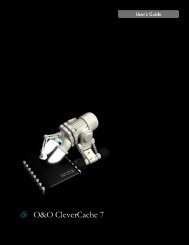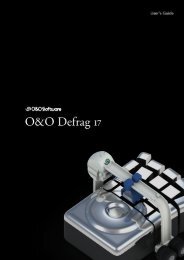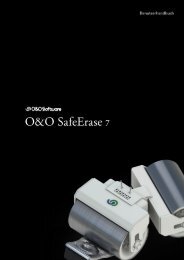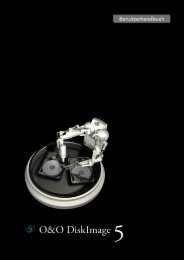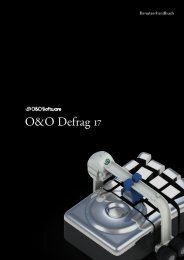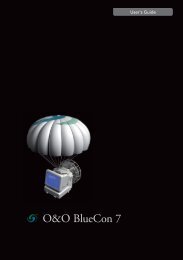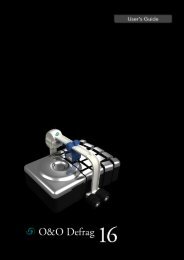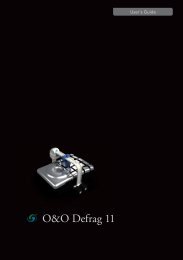O&O DiskImage 7 User's Guide - O&O Software
O&O DiskImage 7 User's Guide - O&O Software
O&O DiskImage 7 User's Guide - O&O Software
You also want an ePaper? Increase the reach of your titles
YUMPU automatically turns print PDFs into web optimized ePapers that Google loves.
Features at a glance<br />
• Storing of a combination from the above mentioned objects (various hard disks, partitions, volumes or similar in<br />
an image)<br />
Different imaging methods<br />
Different imaging methods allow the image to be adjusted for different purposes. You get a space saving image if you<br />
select the setting "Only used sectors". If you want to rescue data from a damaged hard disk, we recommend a forensic<br />
image - all sectors are imaged exactly according to their structure. This enables a later data rescue using special software<br />
such as O&O DiskRecovery without affecting the original disk.<br />
• Image the used sectors of drives (partitions/volumes) - unencrypted data is included in the image.<br />
• Complete image of all sectors of the object to be imaged (forensic image)<br />
• Direct forensic image - encrypted data is also included in the image.<br />
After a base imaging, you can create subsequent images as incremental or differential for storing only the changes:<br />
• Incremental image - saves changes between previous images and the current disk.<br />
• Differential image - saves changes between the very first image and the current status of the disk.<br />
Save image<br />
After creating the image, you can save it on all Windows recognized disks. You only need to enter the network path<br />
before starting the imaging process. The following destinations can be used to store the images:<br />
• Local drives<br />
• External USB or firewire hard disks<br />
• Drive/Folder in the network<br />
• Storing images as ISO files to burn them later<br />
Integrated burn function<br />
Besides the burn function, O&O <strong>DiskImage</strong> supports CD/DVDs, Blue-Ray Disks and HD/DVDs. You also create ISO<br />
files from your images.<br />
Note: Before being able to burn an image (*.omg) onto an optical disk, you'll need to buffer it. It is not possible to<br />
burn a drive while an image of it is being created.<br />
Edit image file<br />
The following editing options are available:<br />
• Combine complete images of different disks onto one image file<br />
• Combine incremental/differential images<br />
• Manual and automatic splitting of images<br />
• Extract objects from images<br />
• Change the encryption and/or compression method of an image<br />
• Change the size of the image by splitting or combining individual images<br />
Compress image<br />
You can compress an image to save even more disk space. Besides LZNT1- you can also compress an image in<br />
BZIP2.<br />
O&O <strong>DiskImage</strong>-8



